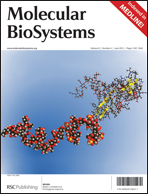Proteomic analysis of a drosophila IBMPFD model reveals potential pathogenic mechanisms†
Abstract
IBMPFD, Inclusion body myopathy associated with Paget's disease of bone and frontotemporal dementia, is a hereditary degenerative disorder due to single missense mutations in VCP (Valosin-Containing Protein). The mechanisms of how mutations of VCP lead to IBMPFD remain mysterious. Here we utilize two-dimensional difference gel electrophoresis (2D-DIGE) combined with mass spectrometry to study the IBMPFD disorder at the protein level. With this set-up, we are able to employ comparative proteomics to analyze IBMPFD disease using Drosophila melanogaster as our disease model organism. Head proteome of transgenic D. melanogaster expressing wild type VCP is compared, respectively, with the head proteome of transgenic mutant type VCPs that correspond to human IBMPFD disease alleles (TER94A229E, TER94R188Q, and TER94R152H). Of all the proteins identified, a significant fraction of proteins altered in TER94A229E and TER94R188Q mutants belong to the same functional categories, i.e. apoptosis and metabolism. Among these, Drosophila transferrin is observed to be significantly up-regulated in mutant flies expressing TER94A229E. A knock-down experiment suggests that fly transferrin might be a potential modifier in IBMPFD disease. The molecular analysis of IBMPFD disease may benefit from the proteomics approach which combines the advantages of high throughput analysis and the focus on protein levels.


 Please wait while we load your content...
Please wait while we load your content...